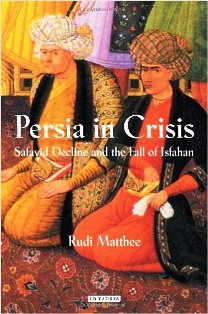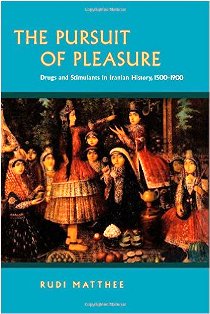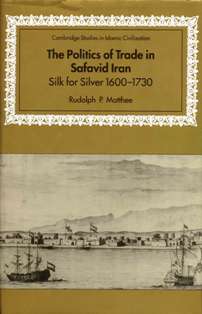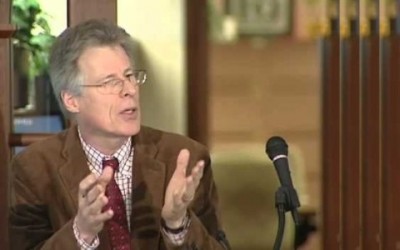Professor Rudi Matthee is the John and Dorothy Munroe Distinguished Professor of History at the University of Delaware. He teaches Middle Eastern history, with a research focus on early modern Iran and the Persian Gulf. His books include The Politics of Trade in Safavid Iran: Silk for Silver, 1600-1730 (Cambridge University Press, 1999); The Pursuit of Pleasure: Drugs and Stimulants in Iranian History, 1500-1900 (Princeton University Press, 2005); Persia in Crisis: Safavid Decline and the Fall of Isfahan (I.B. Tauris, 2012); and, with Willem Floor and Patrick Clawson, The Monetary History of Iran. From the Safavids to the Qajars (I.B. Tauris, 2013). Professor Matthee co-edited, with Beth Baron, Iran and Beyond: Essays in Honor of Nikki R. Keddie (2000); co-edited, with Nikki Keddie, Iran and the Surrounding World, 1501-2001:Interactions in Culture and Cultural Politics (2002); and, with Jorge Flores, Portugal, the Persian Gulf and Safavid Persia (Peeters, 2011). He has also published numerous articles on aspects of Safavid and Qajar Iran.
Professor Matthee served as president of the Association for the Study of Persianate Societies, 2009-2011. He received the 2006 Albert Hourani Book Prize, awarded by the Middle East Studies Association of North America, the Saidi Sirjani Award, 2004-2005, awarded by the International Society for Iranian Studies, the British-Kuwaiti Friendship Book Prize, 2012, and, twice, “Iran’s book of the year world award” from the Iranian Ministry of Culture. To learn more about Professor Matthee’s works you can visit his website:
http://www.history.udel.edu/rudimatthee/fac-bio/rudi-matthee/
Dear Prof. Matthee, it is my great pleasure to have an interview with you about your outstanding contributions to Iranian studies. One of the controversial issues in Iranian studies has to do with what we periodize as “medieval” and “early medieval”. How do you periodize the history of Iran after Islam? Do you find any similarities between the historical phases of Europe as Ancient, Medieval, Early medieval and modern times and the historical phases of Iran?
Of course, the categories we tend to use—ancient, medieval, early modern—are inherently Eurocentric and thus should be applied, if we choose to apply them to a country like Iran, with caution and circumspection. I personally do not find these terms terribly enlightening—other than the newly popular “late-antiquity,” which is appropriate for Iran in denoting the transitional Sasanian period when the country fell under Arab domination and became gradually and partly Islamized. I stay away from “medieval,” preferring to use “premodern.” I do use the term “early modern” for the period c. 1500-c. 1850, although more to mark the Safavid era and its aftermath, including the early Qajar period, than because I think there was any real momentum toward fundamental change in this period. (I think fundamental change only came in the course of the late Qajar period.) As for actual periodization, I consider the Mongol period a clear watershed for opening up Iran to new channels of communication with the outside world, facilitating the introduction of a whole set of new patterns of statecraft, innovative military technology, and ideas about religion and art.
Your excellent book The Politics of Trade in Safavid Iran: Silk for Silver, 1600-1730 is one of the rare sources on Iranian economic system and commercial relations under the Safavids. Can you explain a little about your contributions in this book?
My aim with The Politics of Trade in Safavid Iran was fourfold: to break out of the exclusively religio-political and dynastic framework within which the Safavids tend to be studied; to show the new and accelerating ways in which the Safavids and the territory they ruled—early modern Iran—became connected to the outside world; to explore the nature of the country’s political economy; and to shed light on the trade flows connecting Iran with Europe at the time in light of the conventional thesis that during the seventeenth century maritime long-distance trade all but destroyed the traditional land-based caravan routes. I used the silk trade as a prism to study these issues—as well as to explore the interaction between the agents of the Safavid state and the representatives of the European maritime companies, thus adding a cultural component to the study. I was able to do so because I had access to the archives of the Dutch East India Company. Safavid chronicles, our main Persian-language source of information for the period, are richly informative yet mostly focus on the shah and the political elite, royal campaigns and court matters. The Dutch merchants stationed in Iran at the time, by contrast, filled their reports with a great deal of information relevant to their business in Iran—the price and volume of commodities, types of money used, and market conditions. Since they also kept track of political conditions at the Safavid court, the activities of the shah, his minions, who was in favor and who was about to fall out of grace, they simultaneously offer valuable political information in “real time,” of the type rarely found in the more stylized and idealized Persian-language source material.
The Pursuit of Pleasure: Drugs and Stimulants in Iranian History, 1500-1900 is a unique interdisciplinary study on Iranian’s ways and items of pleasures. What are the main problems you propose in this book?
The book’s first premise meant to subvert the clichéd dichotomy between an alert, frugal and disciplined West and a lethargic, pleasure-seeking “Orient,” is that every society in human history has had its own use (and abuse) of mind-altering drugs and stimulants. Beyond that, I explore the consumption of a number of mind-altering and mood-enhancing substances, both indigenous ones such as opium and wine and newly imported ones such as tea, coffee, and tobacco. I look at the origins of the latter and the ways in which they were introduced and became indigenized. I explore the tension between legal prohibition and fiscal stimulation. I probe the distinction between life as a normative set of prescriptions and proscriptions and life as lived, unruly practice, and the level of rationalization and hypocrisy applied by clerics and moralists to blur the discrepancy, which exists in all societies, for early modern Iran. Ultimately I argue that, far from being mutually exclusive, indulgence and abstention, hedonism and puritanism, have always coexisted in creative tension in Iranian history and history.
How do you see the reasons for the decline of the Safavids in Persia in Crisis: Safavid Decline and the Fall of Isfahan?
In what I call my “decline” book, I make an argument for the validity and relevance of the currently much maligned term “decline” for the Safavid state. After all, unlike the Ottomans the Safavids fell, hard and fast, in the early eighteenth century, and no amount of denial or can alter that fact—or ignore the need to explore both its immediate and its underlying causes. The questions I pose and try to answer in the book revolve around the reasons of the weakness of the state, both structural and contingent ones, beyond the documented retreat of later shahs from active engagement with state affairs and the rise in power of harem women and eunuchs at the royal court. I identify a number of structural reasons for Iran’s weaknesses, such as a harsh natural environment, a relative lack of economic resources, including easily accessible precious metal deposits, and the heavily tribal make-up of society. One of the contingent factors is the decision to conclude a peace accord with the Ottomans in 1639. It brought lasting peace to the country’s west flank yet led to further neglect of the military, causing an army already sapped by budget cuts to lose what was left of its battle readiness. The other is the growing harassment of non-Shi`is by a state that increasingly operated under the influence of hardline clerics. The growing emphasis on faith as a marker of loyalty and belonging during the reign of Shah Soltan Hosayn alienated above all the Sunnis, Afghans, Lezghis, and Uzbeks in first place, militarily capable tribal peoples who happened to dominate in the exposed and vulnerable borderlands and whose loyalty to Isfahan thus was vital. Their defection from the Safavid cause mightily contributed to the collapse of the state.
5. You have done very scholarly works on the Persian Gulf such as “In Portugal, the Persian Gulf and Safavid Persia”. What aspects of this field of study (the Persian Gulf) interest you?
Mostly the way the role the Persian Gulf played in Iran’s early modern history as the country’s only maritime outlet, connecting it to the world via the Indian Ocean. What really fascinates me is the discrepancy between the central place the Persian Gulf occupies in the modern Iranian imagination and the reality of a body of water that, until modern times, was not well integrated into the polity and frequently not even controlled by the central state. The presumed centrality of the Persian Gulf to Iran in the premodern and early modern period is inaccurate, anachronistic, reflecting twentieth-century nationalism rather than historical reality.
One of the interesting topics that you follow in your studies is the foreign relations of Iran with other countries including Russia, Britain, and Portuguese. In terms of foreign relations, do you regard the Safavids as an Empire?
In my written work I have always considered Iran in context, as part of a larger universe and interacting with the world, both the lands immediately surrounding it and the transregional world. This approach springs from my belief that, for all its civilizational splendor, Iran was never just a “repository of authenticity,” and that before the country became a nation state in the twentieth century, it was a land of extreme multiplicity and diversity—linguistically, ethnically, and religiously—a territory with porous borders, open to outside influence, ruled by tribal leaders of mostly Turkic stock—in short, an amalgamation of “identities” loosely held. So, yes, Safavid Iran was an empire in the sense that it was a vast, ecologically and culturally diverse territory overseen by an ideologically motivated dynasty. Safavid Iran was also an empire in the sense that it consisted of an archipelago of oases made up of largely autonomous towns and their respective hinterlands that nevertheless exhibited patterns of civilizational unity.
What are the significant differences between the foreign policies of Iran under the Safavids and the Qajar?
The main difference between the two regimes, as I see it, is that the Safavids exhibited a sense of self-confidence and even superiority in their standing in the world, whereas the Qajars projected powerlessness born of humiliation without the prospect of retribution and a resulting lack of direction in an age that increasingly demanded clarity of purpose. The Safavids dealt with the outside world on an equal footing; they acted in a supremely self-assured manner with especially non-Muslim countries, convinced that the shah was, if not the pivot of the universe, the envy of the world, so that foreign emissaries came to Iran to pay homage to him. Outsiders behaved accordingly, at least outwardly, acting as petitioners and operating at the sufferance of the shah. The Qajars by contrast, already hampered by a legitimacy deficit for lack of religious credentials, labored under the shadow of the humiliating defeat Iran suffered at the hands of the Russian at the beginning of their reign. They had few tools at their disposal to meet the challenges of imperialism and to confront the “modern world” in a productive manner, making it work to Iran’s benefit. Foreigners at the time, the Russians and the British in first place, increasingly demanded and commanded rather than requested, and at times the rulers in Tehran arguably operated at the sufferance of the governments of St. Petersburg, Calcutta, and London.
You have studied different aspects of the history of Iran under the Safavids, the Qajar as well as the Persian Gulf, and also you are familiar with the contributions of different scholars of Iran and other countries to Iranian studies. In terms of content and methodology, what primary points do you think scholars need to take into account to develop Iranian studies?
There are many periods and topics that still await basic research on historical facts and developments. Examples are the little understood period prior to the rise of the Safavids, and the turbulent eighteenth century. The question of historiography—the way history is written, from which angle and for whose benefit—is an increasingly important field of study. As for methodology, a deepened comparative approach, and a transnational perspective are in my opinion promising avenues for future research. For this to be fruitful, it is imperative that Iran scholars acquire at least a reading knowledge of languages other than Persian and English, and in particular of Russian and Ottoman Turkish, the languages of Iran’s two most consequential neighbors.
Can you explain a little about your upcoming studies on Iranian History?
I am working on two long-term projects. One addresses the question of the role Iran and in particular the Safavids played in the protracted anti-Ottoman struggle that exercised the nations of Christian Europe from Portugal to Russia for centuries and that led them to establish contact with Iran’s rulers in an attempt to forge an anti-Turkish alliance. The other is an effort to trace the formation and trajectory of Iranian “identity” over time, identifying forms of continuity alongside manifestations of change between the Safavid and the Qajar periods across the poorly understood eighteenth century.
Thank you very much for your consideration and time.
Interviewed by: Maryam Kamali





